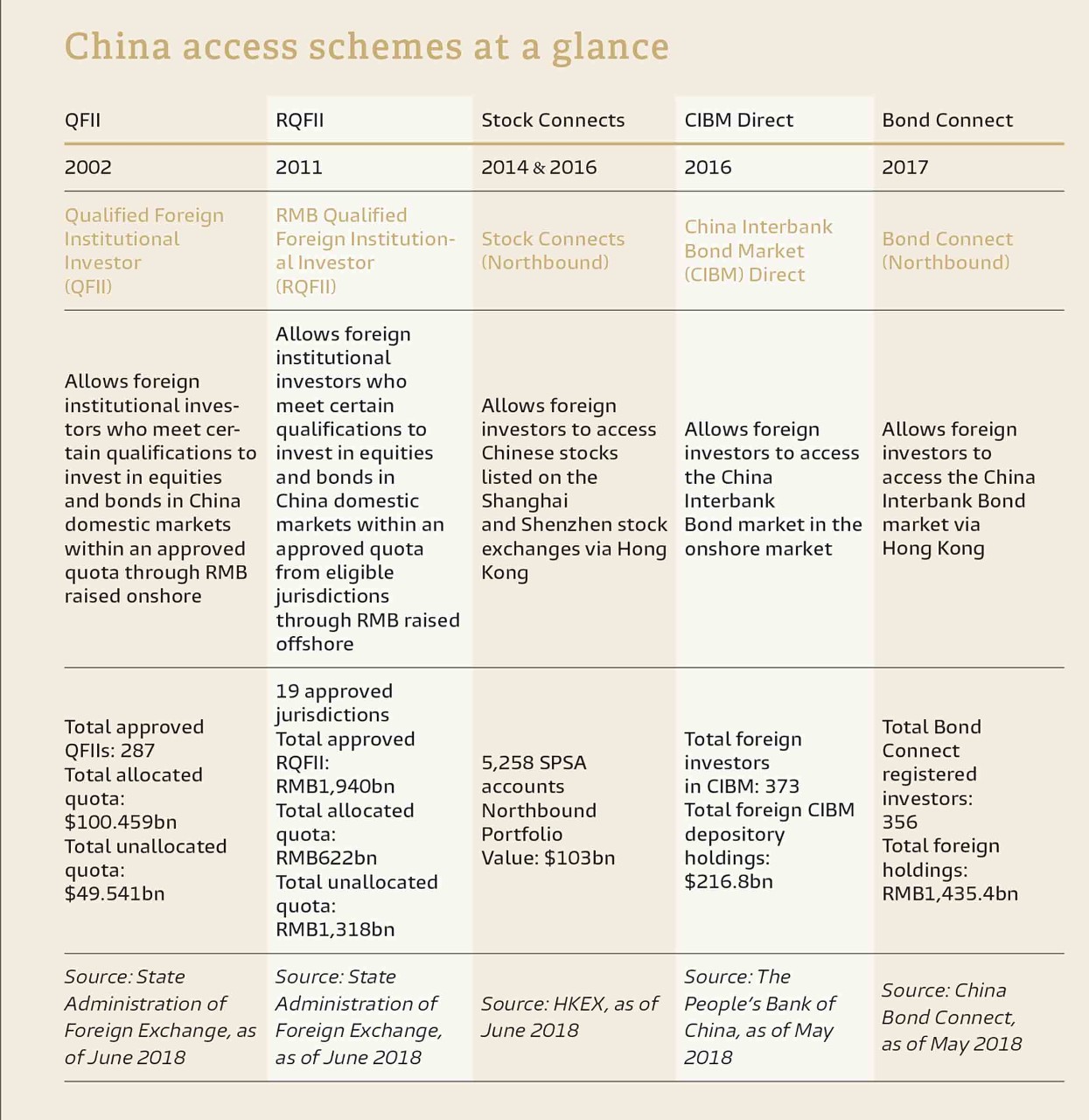A Greater Gateway to China Q&A

A Greater Gateway to China Q&A
November 2018
By Mark Nelligan,
Mathew Kathayanat
Mark Nelligan and Mathew Kathayanat, of BNY Mellon, unveil the challenges and opportunities with the access schemes into China’s capital markets.
This article originally appeared in Hong Kong 2018 Special Report of HFM and is reprinted here with permission.
How have China’s capital markets been liberalising over time and what opportunities exist for foreign investors?
China has traditionally been closed to foreign investors. Over the years, Chinese regulators have been progressively liberalising its domestic markets and relaxing its rules in an attempt to align with international standards, making it simpler and more accommodative to asset managers and asset owners. This poses unprecedented opportunities for foreign investors looking to tap into the China onshore markets – the world’s second largest equity market ($9.28trn) and the world’s third largest bond market ($11.2trn).
How have the access schemes been serving to make foreign participation easier?
The Chinese regulators have relaxed investment restrictions to encourage foreign participation in the China domestic market. Principally, market accessibility has eased tremendously to allow quick access to domestic equity and bond markets. Investment quotas are lifted, and the introduction of true delivery-versus- payment (DvP) settlement system for transactions through Stock and Bond Connect schemes effectively mitigates counterparty risk as cash payment is due at the time of securities being delivered. This enhancement is a critical requirement for regulated funds such as Ucits.
Further, capital mobility has vastly improved for QFII and RQFII schemes, making it easier for foreign institutional investors to inject funds into China without the lock-up period or the need to repatriate on daily basis.
With these different schemes available and the ETF Connect looming, how do foreign investors assess and select the desired scheme(s) for their investment strategy?
With the existing different schemes and the ETF Connect impending, the quandary becomes which scheme(s) to choose as an independent investment strategy or in tandem with your current investments through other schemes.
Take the Stock Connects, which enable foreign investors to access certain eligible China A-shares without any long-term commitment. Investing via the Stock Connects requires little planning or set-up. However, as an investor under the Stock Connects, you are just one in the mass of the Hong Kong Stock Exchange (HKEX) investors to whom a daily overall trading limit of RMB52bn ($8bn) applies. Once the daily trading limit is reached, no further purchase is permitted.
In comparison, as a RQFII holder, you will be treated, in all other respects, the same as a direct onshore Chinese investor. You will only be subject to the individual quota granted by the Chinese regulators, without being restricted to Eligible Stock Connect China A-shares only or to any daily trading limit, and you will also have greater access and exposure to the domestic equity market.
In addition to the overall daily trading limits, also bear in mind that the Stock Connects are ‘indirect’ investment schemes, which only enable investors to have access to Eligible Stock Connect China A-shares through the Hong Kong Securities Clearing Company Limited (HKSCC) as the investor’s nominee to hold those securities.
If your interest is solely in trading bonds and not equities, it would appear that the China Interbank Bond Market (CIBM) Direct Access Scheme or the Bond Connect would be more ideal. However, while the CIBM Direct Access Scheme is wider than the scope of QFII/RQFII insofar as bonds only are concerned, the CIBM Direct Access Scheme only applies to onshore Chinese bonds, but not equities. The RQFII scheme allows investments directly in both equities and bonds and, therefore, for an investor that wants to have access to both equities and bonds, the CIBM Direct Access Scheme and Bond Connect would not give them the investment scope that the RQFII scheme would.
Perhaps the answer to the question of which China access scheme to consider really boils down to what kind of investor you are and your purpose or strategy with respect to Chinese assets.

China Access Schemes At a Glance
Which China access scheme to consider really boils down to what kind of investor you are and your purpose or strategy with respect to Chinese assets.
What are some of the key challenges currently faced by foreign investors, and what are the potential solutions and opportunities ahead?
At present, there are three key challenges for future schemes – namely, regulatory, market structure and overall enhancement.
The first challenge arises from the discrepancy between the regulatory regime in mainland China and international practices for short selling, block trading and holiday trading arrangements.
For example, key market participants and global investors would like block trading to be made available via Stock Connects; however current regulatory restriction requires the transfer of China securities to be conducted on a China stock exchange. Holiday trading arrangements also restrict trading opportunities as investors are not allowed to trade on Stock Connects one day before a public holiday in Hong Kong or mainland China.
The second challenge is around market structure. Currently, Stock Connects are bound by same-day T+0 trade settlements on China A-shares. In comparison, Bond Connect, the scheme for bonds, has the flexibility of processing on T+1 and T+2 settlement basis, so trade confirmation is not an issue. However, implementing changes to a T+0 settlement cycle for Stock Connects is not an easy task.
RMB remains the popular choice among investors on Bond Connect where both offshore CNY (CNH) and onshore CNY can be used. However, there is a limited number of RMB banks that they can engage with for onshore CNY, and investors can only engage with one RMB settlement bank for both capital inflows and outflows. This one-settlement bank requirement is currently causing a lot of confusion because there is no market standard in place.
Last but not least, the complexities behind the market adaptation of future schemes pose a challenge. As FTSE and Bloomberg announce their expansion of China A-share and bond inclusions into their index franchise respectively, investors can expect to see enhanced and increased demand for China A-shares and bonds. This means that Chinese regulators will need to work closely with industry players to address funding, and ensure the system is robust and performing at a zero-error level to continuously gain investors’ confidence.
With the advancement and innovation in technology, post-trade services can be enhanced to provide efficiency and resiliency. Market participants and regulators are developing innovative solutions to address some of the current challenges, including different time zones and T+0 settlement cycle for Stock Connects.
Conclusion
Amid the challenges, China’s financial markets present significant opportunities for foreign investors. Undeniably, there are still several considerations of foreign investors’ needs that Chinese regulators need to address to ease capital access and improve cost efficacy. While the merger of the five schemes is not something that can be addressed in the immediate future, we do anticipate exciting changes to take place in the upcoming years as China continues to open up its capital markets to foreign investors.
This article is licensed from HFM and may include the views of third parties and may include the views of third parties, which do not reflect the views of BNY Mellon or any of its subsidiaries or affiliates. Material contained in this article, which may be considered advertising, (i) is for general information and reference purposes only and is not intended to provide or be construed as legal, tax, accounting, investment, financial or other professional advice on any matter, and is not to be used as such; (ii) does not constitute a recommendation by BNY Mellon (including its subsidiaries and affiliates) of any kind; and (iii) may not be comprehensive or up to date. BNY Mellon (including its subsidiaries and affiliates) makes no guarantee or representation with respect to, and accepts no direct, consequential or any other legal liability whatsoever arising from or connected to, the accuracy, timeliness, completeness, reliability or fitness for a particular purpose of any information contained in this article. BNY Mellon (including its subsidiaries and affiliates) will not be responsible for updating any information contained in this article and the opinions and information contained therein are subject to change without notice. Trademarks, logos and other intellectual property contained in this material belong to their respective owners.
©2018 The Bank of New York Mellon Corporation. All rights reserved.





